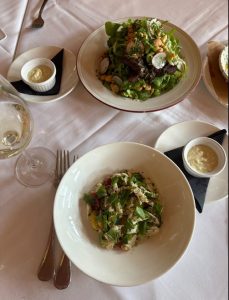‘Truth Tree’ speech bubbles fail to send message
October 5, 2016
This fall, Tulane’s campus had a large new addition that was hard to miss. Hank Willis Thomas’ “Truth Tree” replaced “Companion (Passing Through)” by KAWS, or what many came to know as the “Sad Mickey Mouse.”
A contemporary artist based out of Brooklyn, New York, Thomas’ “Truth Tree” comes out of a series of works called “Hank Willis Thomas: The Truth Is I See You,” which is based around the idea of finding the “truth.” The sculpture itself is on loan from Jack Shainman Gallery. The series contains comic book-like sculptures in the shape of speech bubbles. While some speech bubbles are empty, others have single words, or punctuation.
The “Truth Tree,” which stands outside Woldenberg Art Center in the Newcomb Pottery Garden contains six speech bubbles with the words and exclamations “The,” “Truth,” “Is,” “Love,” “You,” “!” and “?.”
“[‘Truth Tree’] has that kind of comic, graphic novel vocabulary . . . so that it’s not too much a shift in sculpture [from KAWS’ piece],” said Monica Ramirez-Montagut, the Director of the Newcomb Art Museum.
Ramirez-Montagut was originally an architect but found the world of art much more impactful, thus her choice to make the switch in career trajectory. Ramirez-Montagut is also part of the Tulane Forum, a group of faculty and staff that get together to decide on themes and topics for the student body to discuss. This year, the chosen theme is “power,” which she believes is a good topic for generating conversation.
“Within the frame of power, questioning what is the truth… seems to be sort of the ultimate aspiration for many of us,” Ramirez-Montagut said.
Another factor that played into Ramirez-Montagut’s decision was the perception that Thomas is an artist with conviction, at the forefront of social-political discussions, which would hopefully catalyze discussion among students.
Some Tulane students, however, are less enthusiastic about the new statue.
“It’s modern, which I like, but it doesn’t seem like it really says anything,” freshman Fiona Lightbody said.
Some students do not seem to think that this year’s statue speaks to them the way “Companion (Passing Through)” did. Perhaps the idea of depression and anxiety, which many believed KAWS’ piece represented, was more relatable to students than the idea of truth and power.
“It kind of looks poorly made, the bubbles are kind of boxy… [it] doesn’t really connect the message from words to the students,” sophomore Hannah Anderson said.
The shift from such a striking statue to one that is more subdued also means that many students may not have even noticed its more subtle details.
So far, the statue does not seem to have generated the discussions about power and truth as was originally intended. Students’ lackluster attitude toward the statue may stem from the lack of information regarding it. The Newcomb Art Museum does not currently have much information available about the statue, online or otherwise. Unlike last year, there is no accompanying exhibit inside the Newcomb Art Museum to compliment the statue.
While perhaps less provocative than “Companion (Passing Through)”, the “Truth Tree” still has time to incite discussion, as it is on view for the duration of the academic year.









Leave a Comment